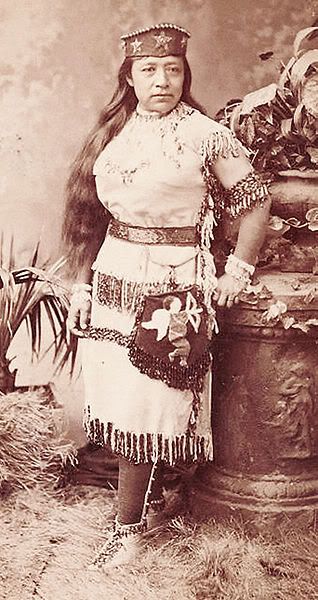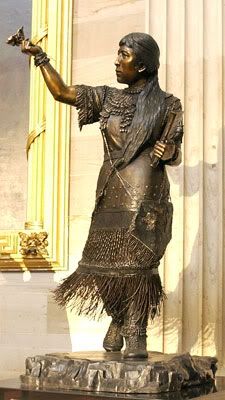In 1879, Sarah Winnemucca, a Paiute from Nevada and the daughter of Chief Winnemucca, gave a series of lectures in San Francisco and Sacramento on the treatment of Indians by the Indian Service. Five years later her autobiography, Life Among the Paiutes: Their Wrongs and Claims, was published. Winnemucca then traveled throughout the country giving lectures on the conditions in Indian country, often charging the government with mismanagement of Indian affairs. Sara Winnemucca became the most recognized Indian woman of the late nineteenth century.

With regard to Paiute women, Sarah Winnemucca wrote:
“The women know as much as the men do, and their advice is often asked. We have a republic as well as you. The council-tent is our Congress, and anybody can speak who has anything to say, women and all.”
She also described women warriors who fought alongside their husbands.
Sarah Winnemucca was born about 1844 in western Nevada. Her father was Winnemucca, sometimes called Old Winnemucca by historians. Her Paiute name was Tocmectone (Shell Flower). When she was about 10, she went with her mother and siblings to live with her grandfather, Truckee, on a ranch near San Jose, California. In 1860, she attended St. Mary’s Convent School in San Jose for a short time. After a month in the school, she was discharged because the non-Indian parents objected to having Indians in the school.
In 1866 some of the Paiute bands in the Snake River region under the leadership of Paulina and Weawea rebelled against the United States. The U.S. military asked Sarah and her brother Naches to come to Fort McDermitt, Nevada to discuss the relationships between the Paiute and the government. She was also asked to help persuade her father to bring his people to the Pyramid Lake Reservation. With her knowledge of both English and Paiute, she was hired by the army as their official interpreter to the Shoshone and Paiute.
In 1870, she travelled to San Francisco where she met with General John Schofeld. She then went to Gold Hill, Nevada where she met with Senator John Jones. In both meetings she complained about the mistreatment of the Paiutes by the Indian agents. Both General Schofeld and Senator Jones, however, claimed that this problem was not under their jurisdiction.
After the Paiute were forced to move to the Malheur Reservation in Oregon, Sarah became friends with the Indian agent, Samuel Parrish. She felt that his agricultural program was beneficial to the Indians. She acted as his interpreter and also taught in the local school.
Four years later, the new Indian agent fired Sarah because she had complained that the teacher and other employees were cheating the Indians at cards. The new agent also told the tribes that the reservation did not belong to the Indians but to the government. Under the new regulations, the Indians had to work for $1 per day and with this money they were to buy their food and clothing from the government store. If the Indians did not like the new policies, they could leave.
During the 1878 Bannock War, Sarah was hired by General O.O. Howard as an interpreter. She also helped the army track the Bannock from southwestern Idaho into eastern Oregon. She persuaded her father and about 75 of his people to escape from the Bannock camp and to the safety of an army post. In spite of her aid to the army, the peaceful Paiute were relocated to the Yakama Reservation in Washington.
When she arrived in San Francisco to deliver her public lectures, the newspapers headlined her as “Princess Sarah.” The San Francisco Chronicle reported:
“Sarah has undergone hardships and dared dangers that few men would be willing to face, but she has not lost her womanly qualities, and succeeded during her visit in coaxing into her lap two little timid ‘pale-faced’ children, usually shy of strangers, who soon lost their fear of her dark skin, won by her warm and genial ways. She speaks with force and decision, and talks eloquently of her people. Her mission, undertaken at the request of Chief Winnemucca, is to have her tribe gathered together again at their old home in Nevada, where they can follow peaceful pursuits and improve themselves.”
One columnist wrote:
“The lecture was unlike anything ever before heard in the civilized world-eloquent, pathetic, tragical at times; at others her quaint anecdotes, sarcasms and wonderful mimicry surprised the audience again and again into bursts of laughter and rounds of applause.”
In her public lectures in San Francisco and Sacramento, Sarah argued that the peaceful Paiute had a right to return to the Malheur Reservation. When federal officials got word of her negative criticism of the Indian Service, they brought Sarah, her father, and other Paiutes to Washington, D.C. Here she talked with federal officials and again made the case for mismanagement. She argued for the rights of her people to return to the Malheur Reservation and manage their own affairs. While the Secretary of the Interior agreed that the Paiute have the right to return to the Malheur Reservation, the necessary funding for the return was not provided.
While in Washington, the Indian Office did its best to keep newspaper reporters away from Sarah. After one reporter managed to get an interview, she was called into the office of the Secretary of the Interior and told:
“I don’t think it will be right for you to lecture here after the government has sent for you, and your father and brother, and paid your way here. The government is going to do right by your people now. Don’t lecture now; go home and get your people back on the reservation; get them located properly; and then if you want to come back, … we will pay your way here, and back again.”
To counteract the negative publicity generated by Sarah Winnemucca, countercharges about her good character were soon circulated. The Indian agent from the Malheur Reservation claimed that Sarah Winnemucca was a notorious, untruthful, drunken prostitute. Her military friends, including General Howard, however, defended her.
In 1881 a Paiute delegation, which included Sarah Winnemucca, met with President Rutherford B. Hayes. President Hayes came into the room and pontificated about Indian assimilation. The entire meeting lasted for about five minutes.
In 1881, General Howard gave Sarah a job teaching Indian children at the army post in Vancouver, Washington.
From 1883 to 1884, she toured eastern cities giving about 300 lectures on Indian rights. Her lectures included “The Indian Agencies” and “The Indian Question as Viewed from an Indian Standpoint.” During this time she met a number of notables, including Mary Tyler Mann (the widow of Horace Mann), Elizabeth Palmer Peabody (Mary Tyler Mann’s sister), Ralph Waldo Emerson, John Greenleaf Whittier, and Senator Henry Dawes. Her book, Life Among the Paiutes: Their Wrongs and Claims, would be edited by Mrs. Mann.
She returned to Nevada and in 1885 opened a school for the Paiute in Lovelock. The school had financial support from a group of non-Indian women in the east as well as the government. Among those who supported the school was Miss Elizabeth Palmer Peabody in Boston, who raised money in Sarah’s behalf by various public appeals. The school was often called the Peabody Indian School in honor of its benefactor. She operated the school for three years.
The Indian Rights Association inspected the school and reported that Sarah Winnemucca had no claim to Paiute leadership. The Association accused her of a variety of “immoralities and vices.”
Sarah Winnemucca died in 1891 at her sister’s home in Henry’s Lake, Idaho. The New York Times printed her death notice and a review of her life. Colonel Frank Parker wrote:
“She was the only Indian on this coast who ever took any prominent part in settling the Indian question, and as such her memory should be respected.”
General O.O. Howard wrote:
“She did our government great service, and if I could tell you but a tenth part of all she willingly did to help the white settles and her own people to live peaceably together I am sure you would think, as I do, that the name of Toc-me-to-ne [or Shell-flower] should have a place beside the name of Pocahontas in the history of our country.”

Leave a Reply